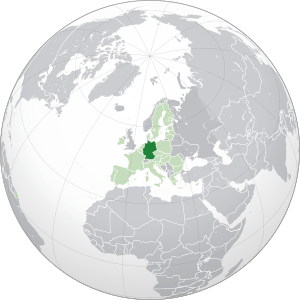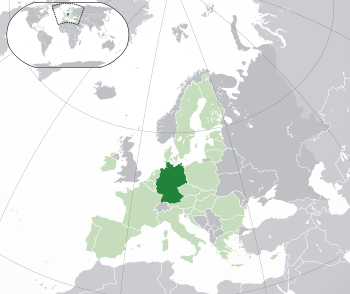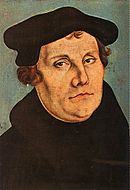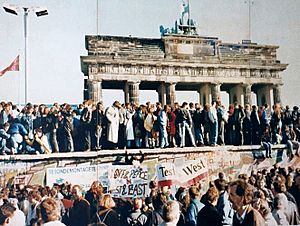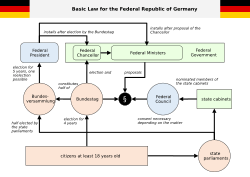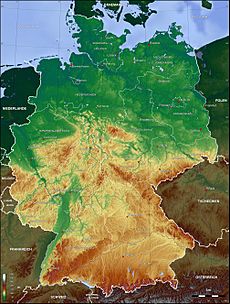Germany facts for kids
Quick facts for kids
Federal Republic of Germany
Bundesrepublik Deutschland (German)
|
|
|---|---|
|
Anthem: "Das Lied der Deutschen"
("The Song of the Germans") |
|
|
Location of Germany (dark green)
– on the European continent (light green & dark grey) |
|
| Capital and largest city
|
Berlin 52°31′N 13°23′E / 52.517°N 13.383°E |
| Official languages | German |
| Demonym(s) | German |
| Government | Federal parliamentary republic |
| Frank-Walter Steinmeier | |
| Friedrich Merz | |
| Legislature | |
| Bundesrat | |
| Bundestag | |
| Area | |
|
• Total
|
357,596 km2 (138,069 sq mi) (63rd) |
|
• Water (%)
|
1.27 |
| Population | |
|
• Q3 2024 estimate
|
|
|
• 2022 census
|
|
|
• Density
|
234/km2 (606.1/sq mi) (58th) |
| GDP (PPP) | 2024 estimate |
|
• Total
|
|
|
• Per capita
|
|
| GDP (nominal) | 2024 estimate |
|
• Total
|
|
|
• Per capita
|
|
| Gini (2023) | ▲ 29.4 low |
| HDI (2023) | very high · 5th |
| Currency | Euro (€) (EUR) |
| Time zone | UTC+1 (CET) |
|
• Summer (DST)
|
UTC+2 (CEST) |
| Date format |
|
| Calling code | +49 |
| ISO 3166 code | DE |
| Internet TLD | .de |
Germany, officially called the Federal Republic of Germany, is a country in Central Europe. It is located between the Baltic Sea and the North Sea in the north and the Alps mountains in the south. Germany has sixteen states. Over 82 million people live there, making it the most populated country in the European Union.
Germany shares borders with many countries. To the north, it borders Denmark. To the east, it borders Poland and the Czech Republic. In the south, you'll find Austria and Switzerland. To the west, it borders France, Luxembourg, Belgium, and the Netherlands.
The capital and largest city is Berlin. Frankfurt is its main financial hub. The Ruhr area is Germany's largest urban region. People have lived in the area of modern Germany since ancient times. Different tribes, including the Celts and Germanic tribes, settled here.
Germany is a developed country with a very strong economy. It has the largest economy in Europe. Germany is a global leader in many industries, science, and technology. It is one of the world's biggest exporters and importers. The country offers social security, healthcare for everyone, and free university education. Germany is part of many important international groups. It also has many UNESCO World Heritage Sites, which are special places recognized for their cultural or natural importance.
Contents
Germany's Past: A Journey Through Time
Germany has a long and interesting history. It was once known as the Holy Roman Empire. This "First Reich" (meaning empire) began with Charlemagne in 800 AD. It lasted for many centuries, until 1806.
The German Empire and World War I
The "Second Reich" started in 1871. This was when Germany became a unified country. Prussia was the largest state in this new German Empire. Its rulers were called Kaisers. Germany remained an empire for about 50 years.
Germany became unified after winning a war against France in 1871. Later, in World War I, Germany joined with Austria-Hungary. They fought against France and other countries. The war became very difficult, especially in the west, with soldiers fighting in trench warfare. Many lives were lost. The war ended in 1918 when Germany surrendered. The Kaiser also lost his power. After this, a new democratic government, the Weimar Republic, was formed.
After World War I, Germany faced many money problems. This was due to the Treaty of Versailles, which made Germany pay for the war. The worldwide Great Depression also made things worse.
World War II and a Divided Germany
The "Third Reich" was Nazi Germany. This was a very dark period that lasted from 1933 to 1945. It began when Adolf Hitler became the leader. He gained total control of the country. Hitler wanted to unite all German-speaking people in one state. He took over places like Austria and parts of Czechoslovakia.
Hitler's invasion of Poland started World War II on September 1, 1939. At first, Germany took over much of Europe. However, after attacking the Soviet Union in 1941, Germany's forces slowly began to lose ground. The war ended on May 8, 1945, when Germany surrendered. Hitler had died a week earlier.
Because of the war, Germany lost a lot of land. For 45 years, Germany was split into two separate countries: West Germany and East Germany.
East and West Germany: Two Separate Paths
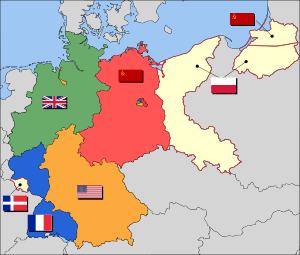
After Germany surrendered in 1945, the Allied powers divided Germany into four zones. The zones controlled by France, the United Kingdom, and the United States joined together. They formed the Federal Republic of Germany (West Germany) on May 23, 1949. The Soviet Union's zone became the German Democratic Republic (East Germany) on October 7, 1949.
West Germany chose Bonn as its temporary capital. East Germany chose East Berlin. West Germany became a democracy with a "social market economy". It received help from the Marshall Plan to rebuild its industries. This led to a period of fast economic growth called the "economic miracle". West Germany joined NATO in 1955 and was a founding member of the European Economic Community in 1957.
East Germany was a communist state. It was controlled by the Soviet Union. The government was run by the Socialist Unity Party of Germany. They had a secret police, the Stasi, which controlled many parts of society. East Germany had a state-controlled economy. Many citizens wanted more freedom and a better life like in West Germany.
To stop people from leaving, the Berlin Wall was built on August 13, 1961. It became a powerful symbol of the Cold War. In 1989, the Berlin Wall fell. This event symbolized the end of communism in Eastern Europe.
In 1990, the two Germanys reunited. The former East German states joined the Federal Republic of Germany on October 3, 1990. This day is now celebrated as German Unity Day.
Reunified Germany and the European Union
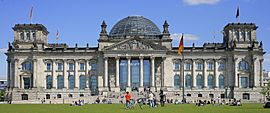
The united Germany continued as the Federal Republic of Germany. Berlin became the capital again in 1999. Germany has played a more active role in the European Union since reunification. It helped create the Eurozone in 1999, which uses the Euro currency.
Germany has also sent peacekeeping forces to other countries. For example, German troops went to Afghanistan to help with security. These actions show Germany's commitment to international cooperation.
In 2005, Angela Merkel became the first female Chancellor of Germany. She led a large coalition government.
How Germany is Governed
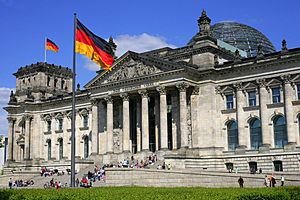
Germany is a federal democracy. This means it is a republic with a system of states. Its political rules are set out in its 'constitution', called the Basic Law. This document was written in 1949.
Germany has a parliamentary system. The parliament chooses the head of government, who is called the Federal Chancellor.
The people of Germany vote for their parliament, known as the Bundestag (Federal Assembly), every four years. Representatives from Germany's 16 States of Germany work in the Bundesrat (Federal Council). The Bundesrat helps to make some laws.
The head of state is the Bundespräsident (Federal President). This person has mostly ceremonial duties.
Germany also has a strong court system. The highest court is the Bundesverfassungsgericht (Federal Constitutional Court). This court can stop any law or action by leaders if it goes against Germany's constitution.
Germany's Landscape and Regions
Germany is one of the largest countries in Europe. It stretches from the North Sea and Baltic Sea in the north to the high Alps mountains in the south. The highest point is the Zugspitze, which is about 2,962 meters (9,718 feet) high.
The northern part of Germany is very flat and low. In the middle, there are low mountain ranges covered with large forests. Further south, before the Alps, there is a plain formed by glaciers from the ice ages.
Germany also has parts of Europe's longest rivers. These include the Rhine River, which forms part of Germany's western border. The Oder River is on its eastern border. Other important rivers are the Danube and the Elbe.
German States
Germany is made up of sixteen states, called Bundesländer. Each state has its own capital city.
|
Within these states, there are many smaller areas called districts (Kreise). There are also independent cities that do not belong to any district.
Germany's Economy and Tourism
Germany has one of the world's strongest and most advanced economies. It is the largest economy in Europe. Bringing East and West Germany's economies together after reunification was a big and costly project.
Germany is part of the G8 group of leading industrial nations. The Ruhr Area is a major industrial region.
Exploring Germany: Popular Tourist Spots
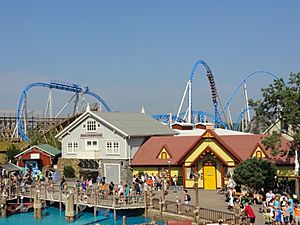
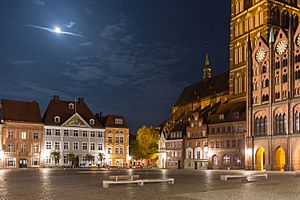
Germany is a very popular country for tourists. It is the seventh most visited country in the world. Many people, both from Germany and other countries, enjoy visiting its cities and countryside. Berlin is one of the most visited cities in Europe.
Germany is famous for its special tourist routes. These include the Romantic Road, the Wine Route, and the Castle Road. The German Timber-Frame Road connects towns with beautiful old timber-framed buildings.
Some of Germany's most famous landmarks are Neuschwanstein Castle, Cologne Cathedral, and the Berlin Bundestag. Europa-Park is also a very popular theme park.
People and Culture in Germany
Most people living in Germany are Germans. There are also many people from other countries and different ethnic groups. Millions of people from other countries live in Germany. Some are guest workers, and some have come seeking safety.
About 50,000 Danish people live in the northern state of Schleswig-Holstein. Around 60,000 Sorbs, a Slavic group, live in Saxony and Brandenburg. The Frisian language, which is similar to English, is spoken by about 12,000 people. In northern Germany, some people also speak Low Saxon.
Many people have moved to Germany from Turkey, including Turks and Kurds. Other groups include Croats, Italians, Greeks, Russians, and Poles. There are also ethnic Germans who moved back to Germany from countries like the former Soviet Union, Poland, and Romania.
Germany has a high level of education and many successful businesses. More young people attend universities now than ever before. German trade and technical schools are known for their quality. On average, Germans have a good income, making it a largely middle-class society. Germany also has a strong social welfare system. This system helps people who are sick, unemployed, or facing other challenges.
Religion in Germany
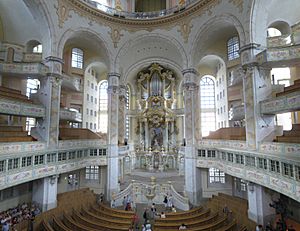
Germany's constitution protects religious freedom. This means everyone can believe in any religion they choose. No one can be treated unfairly because of their religion.
In ancient times, people in Germany followed pagan beliefs. Roman Catholicism became the main religion. But in the 16th century, a big religious change happened. This was the Protestant Reformation, started by Martin Luther in 1517. Luther's ideas led to the rise of Protestantism. Today, Protestantism and Catholicism are the two largest religions in Germany.
About two-thirds of Germans identify as Christian. Most German Protestants belong to the Evangelical Church in Germany. The former Pope Benedict XVI was born in Germany.
Before World War II, there was a significant Jewish community in Germany. Today, the Jewish population in Germany is growing. Many Jewish people have moved to Germany from countries that were part of the Soviet Union. Education about the difficult history of Nazi Germany has helped Germany become more accepting of different people and cultures.
About three million Muslims live in Germany. This makes up about 3.7% of the population. Germany also has many people who are not religious. There are also smaller communities of other religions like Jainism, Buddhism, and Zoroastrianism.
German Culture and Traditions
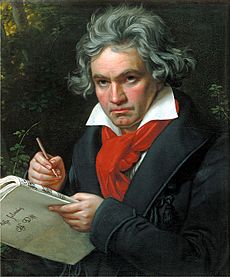
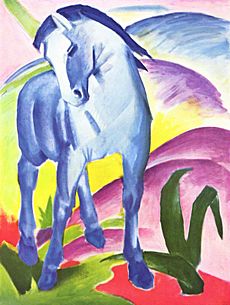
Germany has a rich history of poets, thinkers, and artists. The country has many supported theaters, orchestras, museums, and libraries. Millions of visitors enjoy these cultural attractions every year.
Germany has made great progress in promoting gender equality and disability rights. It also accepts homosexuality, and gay marriage is legal in Germany.
Delicious German Food
Germany is also famous for its food. The food styles can be different from one region to another. For example, in the southern regions like Bavaria, the food is similar to that in Switzerland and Austria.
Across Germany, meat is often eaten as a sausage. While wine is becoming more popular, the national alcoholic drink is beer. Germans are among the biggest beer drinkers in the world. German restaurants are also highly rated for their quality.
Related pages
Images for kids
-
Martin Luther (1483–1546), Protestant Reformer
-
Adolf Hitler, leader of Nazi Germany (1933–1945)
-
German-occupied Europe in 1942 during World War II
-
Frankfurt is a leading business centre in Europe and the seat of the European Central Bank.
-
Heidelberg University is Germany's oldest institution of higher learning and generally counted among its most renowned.
-
A typical German Weihnachtsmarkt (Christmas market) in Dresden
-
The Brothers Grimm collected and published popular German folk tales.
-
Babelsberg Studio in Potsdam near Berlin, the world's first large-scale film studio
-
The German national football team after winning the FIFA World Cup for the fourth time in 2014. Football is the most popular sport in Germany.
See also
 In Spanish: Alemania para niños
In Spanish: Alemania para niños




